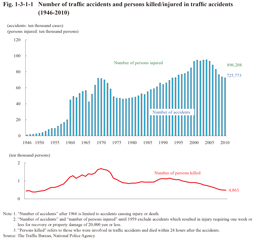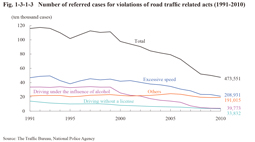Chapter 3 Various Types of Offenses
Section 1 Traffic Offenses
1 Trends in traffic offenses
(1) Occurrence of traffic accidents
Fig. 1-3-1-1 shows the number of traffic accidents and the number of persons killed or injured in those accidents since 1946 (See Appendix 1-5 for details). The number of traffic accidents and the number of persons injured in traffic accidents both remained at a high level from 2000 through to 2004, but then started to decrease for six consecutive years from 2005. The number of persons killed was on a decreasing trend from 1993, and was 4,863 in 2010 (down 1.0% from the previous year).
Fig. 1-3-1-1 Number of traffic accidents and persons killed/injured in traffic accidents(1946-2010)
(2) Dangerous driving causing death or injury and negligence in vehicle driving causing death or injury, etc.
In 2010 the number of persons cleared for dangerous driving causing death or injury was 336 (up 6.0% from the previous year) and that for negligence in vehicle driving causing death or injury, etc. 700,581 (down 2.5% (id.)) (See Table 1-1-1-2). Of these the number of persons cleared in cases involving death was 31 (up 14.8% (id.)) for dangerous driving causing death, 4,002 (down 5.3% (id.)) for negligence in vehicle driving causing death and negligence in the pursuit of social activities causing death, and 29 (up 26.1% (id.)) for causing death through negligence (including causing death through gross negligence) (Source: The Traffic Bureau, National Police Agency).
(3) Hit-and-run cases
Fig. 1-3-1-2 shows the number of hit-and-run cases (cases of breach of the duty to provide first-aid in a road traffic accident on the road, thus causing death or injury) and the clearance rate since 1992. The number of cases sharply increased from 2000, but then decreased for six consecutive years from 2005, and was 11,951 in 2010 (down 399 or 3.2% from the previous year). The clearance rate was on a declining trend from 1996, but then turned to a rising trend from 2005. Limiting the cases to those involving death revealed that the clearance rate generally remained at the high level of more than 90%.
Fig. 1-3-1-2 Number of hit-and-run cases and clearance rate (1992-2010)
(4) Violations of road traffic related acts
The number of processed cases of violations of road traffic related acts, which is the total of the number of notified cases that fell under the traffic infraction notification system as non-penal offenses (hereinafter referred to as “notified cases” in this subsection) and the number of cases referred as penal offenses (hereinafter referred to as “referred cases” in this subsection), remained within the range of eight to nine million from 2003 and was 8,051,070 in 2010 (down 3.6% from the previous year) (Source: The Traffic Bureau, National Police Agency).
The number of notified cases hit a minimum of 6,867,396 in 2001, but then continued to increase. It reached 8,165,633 in 2005, but was then slightly decreasing, and was 7,577,519 in 2010 (down 3.5% from the previous year) (Source: The Traffic Bureau, National Police Agency).
Fig. 1-3-1-3 shows the number of referred cases over the last 20 years. The number reached 1,172,677 in 1992, and then remained stable. It started decreasing sharply from 2000, and fell below 500,000 in 2010 at 473,551. By type of violation, both driving under the influence of alcohol and excessive speed were decreasing from 2000 and 2002, respectively, while driving without a license was also slightly decreasing. Use of an index with the number for 1991 set as 100 revealed that in 2010 the index for driving under the influence of alcohol was 11.8, that of excessive speed 44.6, and that of driving without a license 24.1 (See Section 3, Chapter 2, Part 2 and Section 1, Chapter 3, Part 2).
Fig. 1-3-1-3 Number of referred cases for violations of road traffic related acts (1991-2010)
Fig. 1-3-1-4 shows the percent distribution of notified/referred cases for violations of road traffic related acts by type of violation in 2010. Of notified cases excessive speed accounted for the highest proportion at 28.5%. Of referred cases excessive speed also accounted for the highest proportion at 44.1%, followed by driving under the influence of alcohol, and then driving without a license, and with the three types of violations accounting for approximately 60% of all the referred cases.
Fig. 1-3-1-4 Percent distribution of notified/referred cases for violations of road traffic related acts by type of violation (2010)



